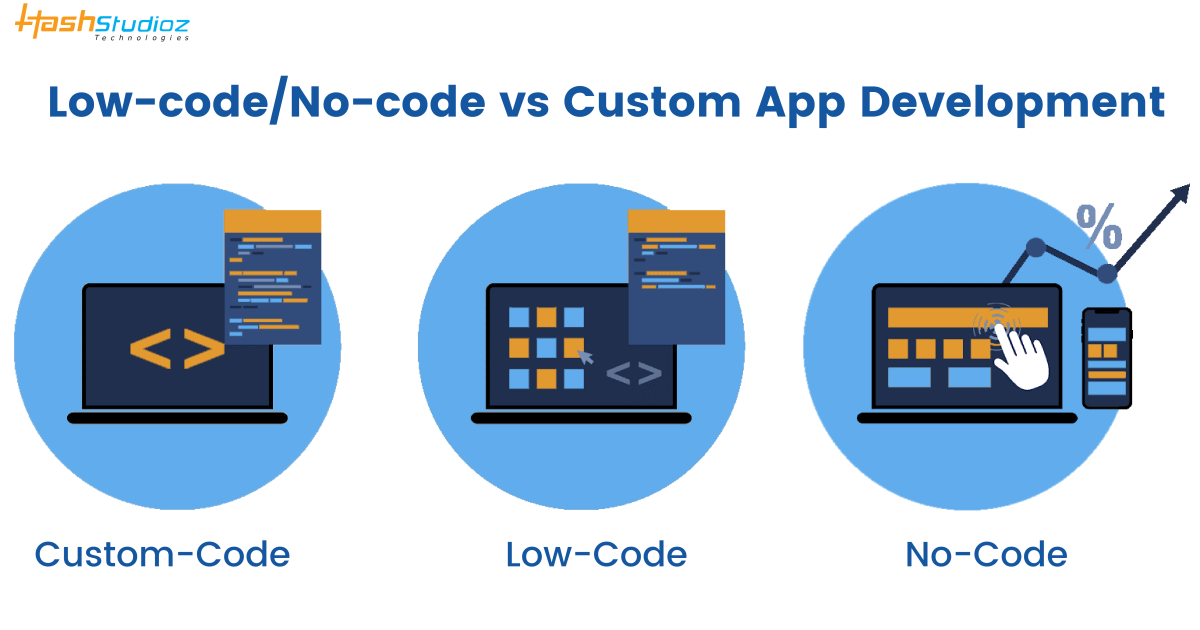Free Info For Choosing Low-Code Platform Recommendations
Free Info For Choosing Low-Code Platform Recommendations
Blog Article
Advantages Of Low-Code Application Development In Terms Of Speed
Low-code application development significantly enhances development speed due to several crucial factors. Development Environment:
Drag-and-Drop Interfaces: Low-code platforms provide visual tools for designing applications. Developers can easily build an application by dragging and dropping elements without having to write code.
Many low-code platforms have prebuilt templates and components. This allows developers to quickly develop or prototype their applications, without having start with a blank slate.
Reduced Coding Requirements
Automated Code Generation Low-code platforms automatically generate the underlying code based on the visual models designed by programmers. It reduces the need to code manually and speeds up development.
Reusable Parts: Developers will be able reuse parts that are reusable across projects and reduce the time needed for writing and testing of code.
Collaboration is simplified:
Integration of Development Tools: Low-code tools usually contain tools for managing versions as well as testing and deployment which facilitates seamless collaboration between development teams.
Citizen Development: Users of businesses and non-developers can help with application development by using intuitive interfaces, thus reducing bottlenecks that is often caused by the limited access to professionals.
Rapid Iteration & Prototyping
Fast prototyping: Developers are able to quickly create prototypes in order to collect feedback and verify ideas, resulting in faster iteration cycles.
Simple Modifications - The visually appealing nature of low-code applications allows for easier changes and updates that speed the process of refining applications based on feedback from users.
Pre-built Integrations:
API Integrations: Low code platforms typically come with connectors to popular APIs and services. This cuts down on the time required to integrate other systems.
Data Integration: Built-in tools for data integration simplify the process of connecting databases and other sources of data and speeding development.
Scaling, deployment and deployment:
One-Click deployment: A lot of platforms using low-code provide an option to deploy applications, reducing time and effort.
Cloud-Based Platforms: Cloud-based platforms that have low-code capabilities can manage infrastructure and scaling, meaning developers can focus on the logic and performance of their applications rather than the logistics of deployment.
The main advantage of developing applications using low-code, in terms of speed, is its ability to automatize and simplify many aspects in the development process. This allows faster delivery of applications, and more rapid adaptation to changing requirements. Read the top the advantage for Low-code Platform for application development for more recommendations including app platforms, sso azure, database in azure, application development platforms, application development platforms, azure sql, rapid action development, multiplatform mobile app development, sso azure, microsoft azure sql and more.
Scalability And Flexibility Are The Two Main Advantages Of Low-Code Application Development
The creation of low-code applications has many benefits, especially in terms scaleability. This is important to develop applications that expand with your company and can adapt as it grows. Three benefits are listed below.
Cloud-based deployment: A lot of low-code platforms are based. This lets applications grow seamlessly in tandem with the cloud infrastructure. This allows companies to handle an increase in workload without having to manage servers.
Auto-Scaling Features: Auto-scaling functions built-in allow for automatic adjustment of resources according to the demand, ensuring a the same performance even during peak hours without the need for manual intervention.
Flexible Architecture:
Modular Design: Low code platforms encourage the modular design of applications, allowing components to be independently designed, tested and scalable. Modularity increases flexibility, and it is easier to update specific parts of an app without having to alter the entire system.
Microservices Integration : In support of microservices architecture, applications can be developed using loosely-coupled services to improve flexibility and scalability.
Customizable Solutions:
Extensibility : Low-code platforms permit developers to extend functions beyond what they are able to provide. This allows developers to satisfy their unique business requirements without any restrictions.
Third-Party Integrations: The integration of third-party APIs, services or other services allows companies to enhance the capabilities of their application by adding new functions.
Agile Development and its deployment:
Continuous Delivery and Deployment Low-code platform support agile methodologies that allow continuous integration and continuous delivery (CI/CD). This facilitates rapid deployment of new features and updates. Applications are then able to grow rapidly in response to market changes and user feedback.
Iterative Development: The iterative nature of development using low-code implies that applications can be improved incrementally and expanded, reducing risk associated with large-scale changes and allowing for more controlled growth.
Resource Optimization
Low-code platforms provide tools to track and manage the performance of an application that help optimize resource usage. This allows resources to be used efficiently, and also to be sized up or down based on the actual need.
Load balancer: The app is able to handle large volumes of traffic efficiently and with a high degree of consistency because of the integrated load-balancing functions.
Global Reach
Multi-Region: Platform deployments that use low-code are typically accessible across multiple countries which allows businesses to offer users with low latency access to all users. This is crucial for applications that cater to users from all over the world.
Support for Localization. Built-in support to localize applications allows them to be easily adapted to different languages, regional requirements and improves their flexibility in various markets.
Maintenance and updates
Simple Maintenance: The visual and modular nature of low-code programs simplify maintenance tasks, allowing updates and bug fixes to be completed quickly and without lengthy downtime.
Version Control: The integrated version control software helps keep track of changes and rollbacks. This ensures that updates can easily be implemented and earlier versions restored when needed.
Cost Efficiency:
Lower development costs: Low-code platforms allow for a reduction in the development cost by eliminating the requirement to code extensively. This enables applications to be expanded without a significant increase in the development cost or effort.
Pay-as-you-go models Numerous platforms that are low-code users offer a variety of pricing options, like pay-as-you go model that aligns costs and usage with actual growth.
The majority of low-code applications developers offer a high level of flexibility and scalability which allows businesses to quickly build robust and flexible apps. These platforms are able to quickly adapt to the changing needs and make the most efficient use of resources, and continually improve, allowing apps as well as businesses to expand and develop. Have a look at the top wavemaker.com coding for site advice including microsoft azure sql, app dev platform, no code platforms, build with docker, app dev platform, cloud software applications, app development platform, azure sql, develop web app, low code platforms and more.
Low-Code Apps Have Many Advantages In The Area Of Collaboration And Workflow
The low-code approach to development of applications has several benefits in regards to workflow and collaboration and collaboration, making it a great choice for companies looking to improve team productivity and streamlining their process of development. Here are the key advantages: Improved Cross-Functional Collaboration:
Unified Development Environment. Low-code platforms let all team members work together in one unified environment. This includes business analysts, developers designers, stakeholder. This reduces silos and promotes better communication.
Visual Development Tools: The graphic, drag-and-drop nature of low-code platforms makes it easier for team members who are not technical to take part in the development process, while ensuring that business requirements are accurately captured and implemented.
Communication Enhancement
Real-Time Collaboration: Many low-code platforms have real-time collaboration features including simultaneous editing, commenting, and instant feedback. These features enable continuous communication and cut down on the time wasted in back-andforth discussions.
Shared Workspaces Teams can collaborate by sharing workspaces. These workspaces permit them to review, edit, discuss and collaborate on project components.
A streamlined Workflow Management System:
Built-In Tools for Project Management: Platforms that are low-code often include integrated project management tools that aid teams in planning to track and manage their development initiatives. This includes the assignment of tasks, tracking progress and managing deadlines.
Workflow Automation Automating routine tasks or workflows permits teams to focus their efforts on more strategic projects and activities and improves the overall efficiency of an organization.
More efficient cycles of iteration:
Rapid Prototyping Low-code platforms are great for speedy prototyping. Iterative development is also feasible and allows teams to experiment, create and improve their apps in shorter periods. This lets feedback be swiftly integrated, and further improvements to be made.
Agile Development Support: Support for agile methodologies allows teams to work in sprints, continually providing small amounts of functionality, making it easier to adjust to evolving requirements.
Accessibility for Non-Developers
Citizens Development: Lowcode platforms permit users of business applications (citizen developers), to create, modify, and maintain applications that do not require a lot of code. This reduces the burden on IT teams as well as developers, enabling them to react more quickly to business demands.
Training and Onboarding - Simple interfaces, comprehensive training resources and user-friendly interfaces make it simple to help new members get up to speed and improve the overall team's collaboration.
Centralized Documentation & Knowledge Sharing
Integrated Documentation: Low-code platforms provide a variety of features which allow the creation and management of documentation on the platform. This will ensure that all project information is accessible and centrally stored.
Knowledge Repositories. Teams are able to build and manage knowledge repositories, which contain best practices templates as well as a reuseable components, making it easier for knowledge exchange and reducing duplicate efforts.
Consistency and uniformity:
Standardized Components. The standardization of components across various applications ensures consistency, which helps to make it simpler to work with and be understood by team members.
Governance and compliance Governance and compliance frameworks that are built-in to ensure that applications are created in line with the organizational standards, regulations requirements, and quality standards. They lower the risk of not adhering to regulations and assure that the application meets the requirements of the standards.
Feedback and Improvement Loops
Integrated Feedback Mechanisms Low-code platforms are typically equipped with built-in feedback mechanisms. These allow users to quickly provide feedback about applications that can later be used in the development process.
Continuous Improvement: The capacity to rapidly iterate and deploy changes based on feedback ensures constant improvement of software which are aligned with user needs and business objectives.
Visualization and reporting:
Real-time analytics: Built-in analytical and reporting tools provide real-time information about the performance of your project, its progress and user interactions. They facilitate an informed, data-driven decision-making.
Visual Workflow Mapping: Visual tools to map workflows can be utilized by teams to improve workflows. This can help them pinpoint the bottlenecks, as well as areas of improvement.
Low-code development has many advantages in regards to workflow and collaboration. It can bring diverse teams together, automate processes, simplify communication and improve teamwork. This creates a more flexible, efficient and collaborative environment for development. This eventually will result in higher quality applications as well as better alignment of goals for business.